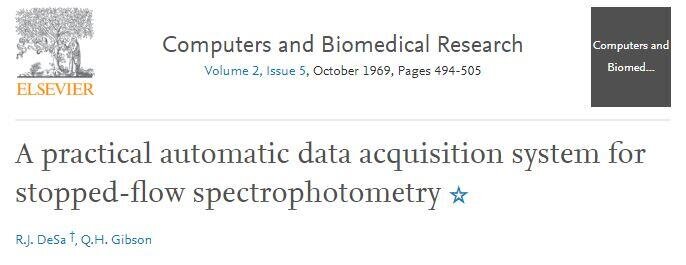The Definitive Guide for Uv/vis/nir
Table of ContentsCircular Dichroism Can Be Fun For EveryoneUv/vis/nir Can Be Fun For AnyoneThe Facts About Spectrophotometers RevealedCircular Dichroism Can Be Fun For EveryoneThe 8-Second Trick For Circularly Polarized Luminescence

Spectrophotometry is a tool that hinges on the quantitative analysis of molecules depending on how much light is taken in by colored compounds.
5 Easy Facts About Circular Dichroism Shown
A spectrophotometer is commonly utilized for the measurement of transmittance or reflectance of solutions, transparent or opaque solids, such as polished glass, or gases. Numerous biochemicals are colored, as in, they soak up noticeable light and for that reason can be determined by colorimetric treatments, even colorless biochemicals can typically be converted to colored compounds appropriate for chromogenic color-forming responses to yield substances appropriate for colorimetric analysis.: 65 Nevertheless, they can likewise be created to measure the diffusivity on any of the listed light ranges that normally cover around 2002500 nm utilizing various controls and calibrations.
An example of an experiment in which spectrophotometry is used is the determination of the equilibrium constant of a service. A specific chemical reaction within a service may take place in a forward and reverse instructions, where reactants form products and items break down into reactants. At some point, this chemical response will reach a point of balance called an equilibrium point.
Everything about Spectrophotometers
The quantity of light that passes through the option is a sign of the concentration of particular chemicals that do not permit light to travel through. The absorption of light is due to the interaction of light with the electronic and vibrational modes of molecules. Each type of molecule has a specific set of energy levels connected with the makeup of its chemical bonds and nuclei and therefore will take in light of specific wavelengths, or energies, leading to distinct spectral properties.
Using spectrophotometers covers numerous scientific fields, such as physics, materials science, chemistry, biochemistry. circularly polarized luminescence, chemical engineering, and molecular biology. They are commonly utilized in numerous markets including semiconductors, laser and optical production, printing and forensic assessment, in addition to in laboratories for the research study of chemical substances. Spectrophotometry is often utilized in measurements of enzyme activities, decisions of protein concentrations, determinations of enzymatic kinetic constants, and measurements of ligand binding reactions.: 65 Eventually, a spectrophotometer is able to figure out, depending upon the control or calibration, what compounds are present in a target and precisely just how much through calculations of observed wavelengths.
Developed by Arnold O. Beckman in 1940 [], the spectrophotometer was produced with the aid of his associates at his business National Technical Laboratories founded in 1935 which would end up being Beckman Instrument Company and eventually Beckman Coulter. This would come as a solution to the previously developed spectrophotometers which were not able to absorb the ultraviolet correctly.
What Does Uv/vis/nir Do?
It would be discovered that this did not offer acceptable results, for that reason in Design B, there was a shift from a glass to a quartz prism which enabled for much better absorbance outcomes - UV/Vis (https://allmyfaves.com/olisclarity1?tab=Olis%20Clarity). From there, Model C was born with a change to the wavelength resolution which ended up having three systems of it produced
It was produced from 1941 to 1976 where the cost for it in 1941 was US$723 (far-UV accessories were a choice at additional cost). In the words of Nobel chemistry laureate Bruce Merrifield, it was "probably the most important instrument ever developed towards the improvement of bioscience." Once it became stopped in 1976, Hewlett-Packard produced the very first commercially readily available diode-array spectrophotometer in 1979 called the HP 8450A. It irradiates the sample with polychromatic light which the sample takes in depending upon its homes. Then it is sent back by grating the photodiode selection which discovers the wavelength region of the spectrum. Because then, the development and implementation of spectrophotometry devices has actually increased profoundly and has actually turned into one of the most innovative instruments of our time.

The Facts About Spectrophotometers Uncovered
Historically, spectrophotometers utilize a monochromator consisting of a diffraction grating to produce the analytical spectrum. The grating can either be movable or repaired. If a single detector, such as a photomultiplier tube or photodiode is utilized, the grating can be scanned stepwise (scanning spectrophotometer) so that the detector can measure the light intensity at each wavelength (which will represent each "action").
In such systems, the grating is fixed and the strength of each wavelength of light is determined by a different detector in the selection. In addition, most contemporary mid-infrared spectrophotometers use a Fourier change technique to get the spectral info - https://www.startus.cc/company/olis-clarity. This strategy is called Fourier transform infrared spectroscopy. When making transmission measurements, the spectrophotometer quantitatively compares the fraction of light that passes through a reference solution and a test service, then electronically compares the strengths of the 2 signals and computes the percentage of transmission of the sample compared to the recommendation requirement.
